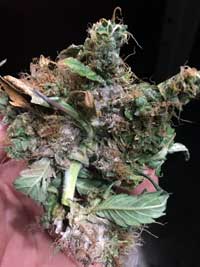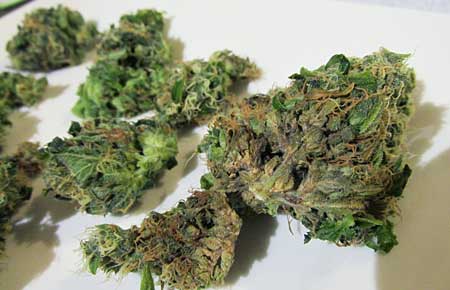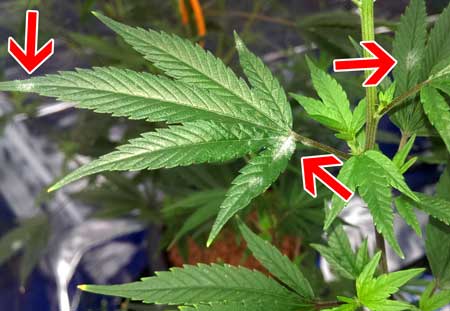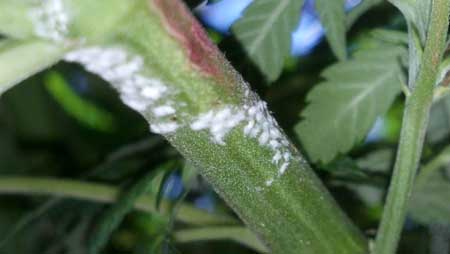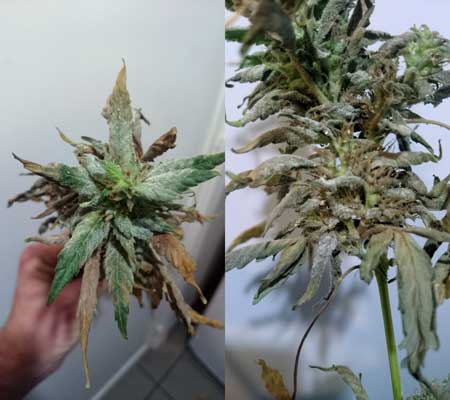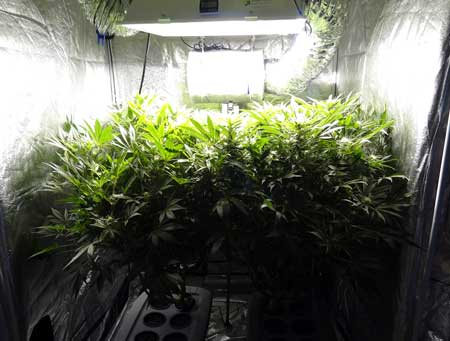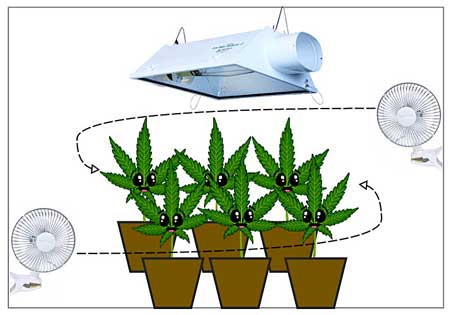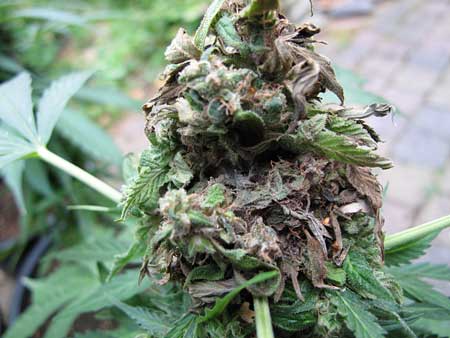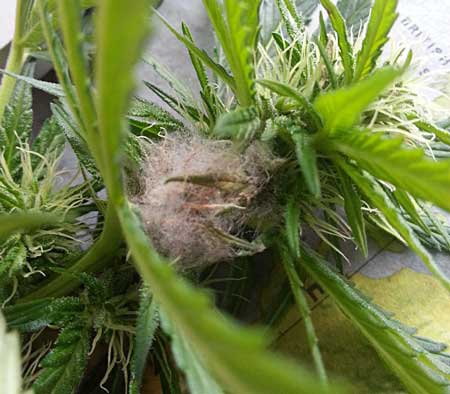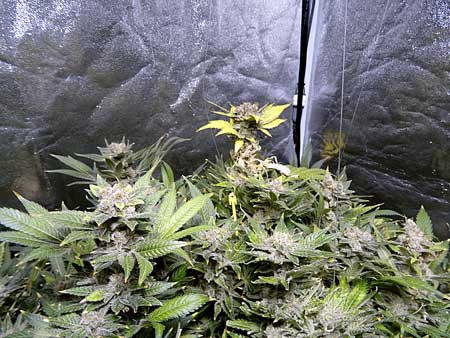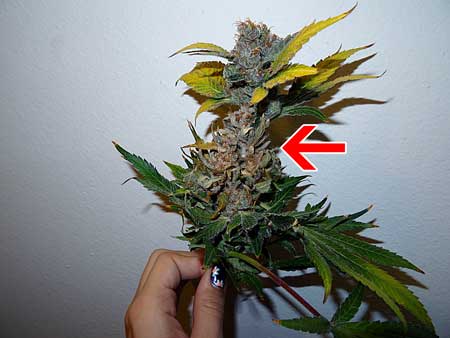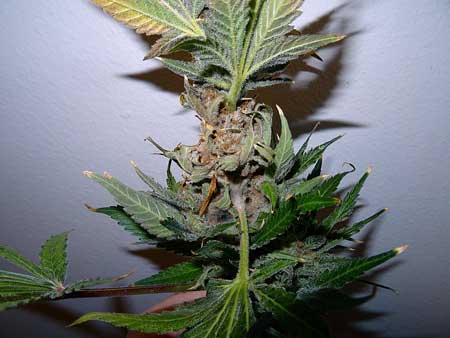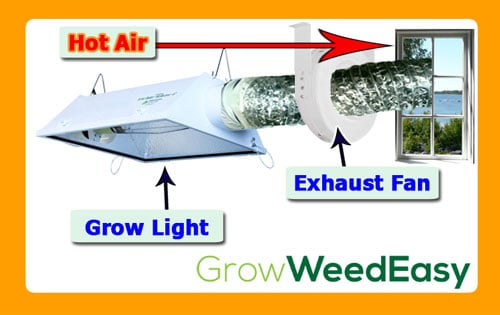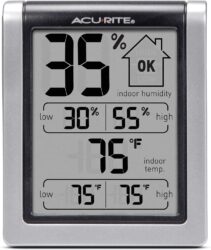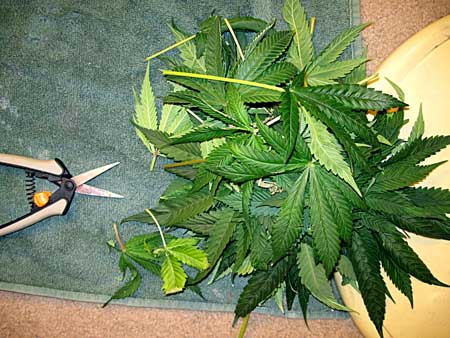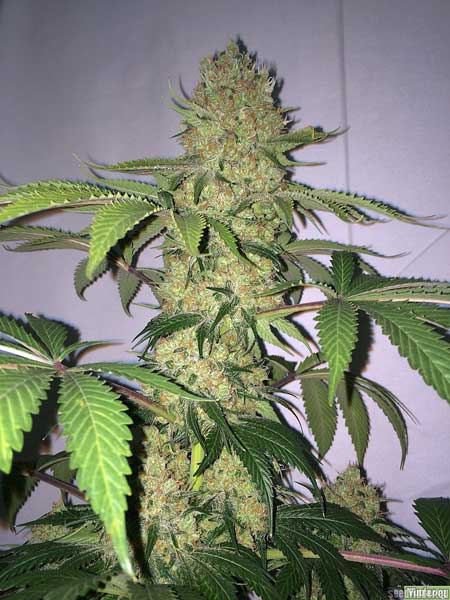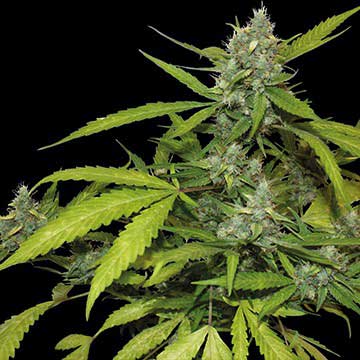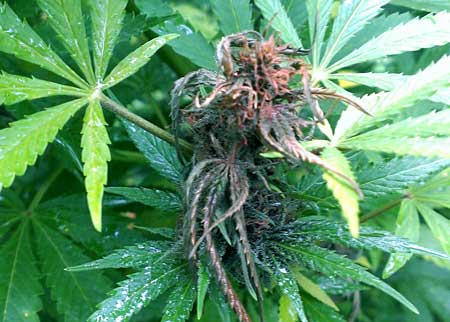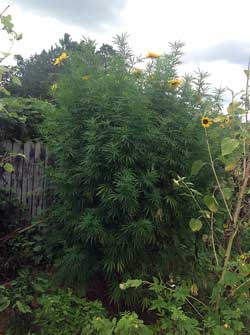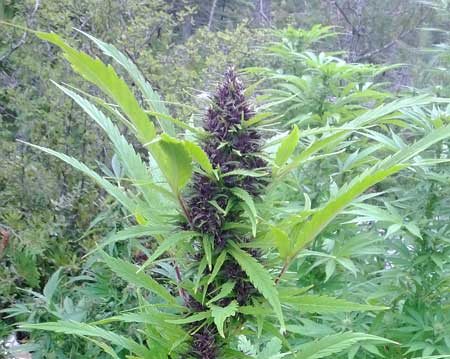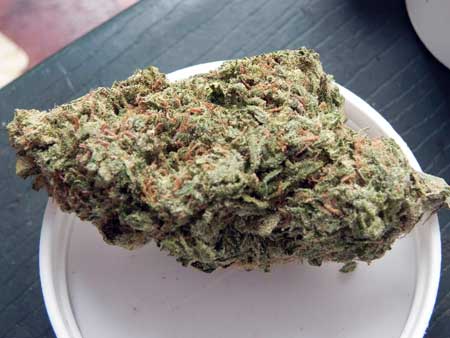by Nebula Haze
Mold. Most people who grow cannabis aren’t thinking about mold at all! But there are 3 main types of mold that often attack unsuspecting cannabis growers…
- White Powdery Mildew
- Bud Rot
- Fuzzy White Mold (Regular Mold)
There’s so many other things besides mold to worry about during your grow, like nutrient deficiencies, plant training, bugs, increasing yields, increasing THC, etc.
But unfortunately, mold has a way of creeping into your life when you least expect it!
It’s possible to get mold at any point at any point in your plant’s life, but even if you make it through your entire grow without mold, the last 2 weeks before harvest (and the first few weeks after harvest) are actually the times when you’re most likely to get attacked!
This is extra frustrating because mold makes buds completely unsafe to smoke, and it most often gets you after you’ve already dedicated months and months of work into your grow. If you’re not careful mold can decimate your entire crop!
Yuck!!!!! NEVER smoke moldy buds! If buds look fuzzy white, brown, black or gray, don’t smoke them!
Even if you’ve had several successful grows, there may be things you’re accidentally doing which can increase your chances of mold. Certain strains are much more susceptible to mold throughout their lives, so good practices will go a long way to making sure mold never gets you no matter what strain you grow!
Luckily, mold is really easy to prevent, and you have a lot of tools to help you combat mold so you never have to worry about it again! If you cover your bases, you can prevent this gross affliction from ever ruining your crops!
All mold comes from spores. But how do the spores get to your plants? They can get tracked in from anywhere at any time, and there’s always some amount of mold spores in the air pretty much everywhere you go. Although it is a really great idea to keep your grow room as sterile and clean as possible, it’s still possible for mold spores to get in no matter what you do.
In fact, NASA has recently started growing various plants in space, and they were shocked to find out that their flowers also started molding in too-humid conditions! Even NASA didn’t know that mold would be able to make it all the way to the International Space Station.
NASA astronaut Steve Swanson showing off the red, blue and green LED lights of the “Veggie” plant growth system on May 7, 2014. Credits: NASA (Do you want to grow cannabis with LEDs?)
The point is that mold spores are probably already in your grow room or around your plants in tiny amounts, but luckily they just can’t grow without the right conditions. Since it’s easy to create an environment to prevent mold from ever taking hold of your plants, you can be sure that any spores will never “blossom” on your plants.
3 Times You Are Most Likely to See Mold
1.) When plants are big and leafy
White Powdery Mildew is a type of mold that attacks when your plants are growing in hot, humid conditions without a lot of airflow; WPM needs stagnant air to grow. It looks a little bit like someone dropped some flour on your leaves, buds or stems.
WPM also grows on stems
A little WPM on your leaves is a bad sign, but if WPM gets out of control it can destroy buds and even kill a whole plant!
Learn more about White Powdery Mildew
WPM can attack your plants and buds at any point in their life, even when they are small, but it’s most common when you have big leafy plants because they reduce airflow and increase humidity. This is most especially true in small spaces like a grow tent. The plant on the right is so leafy that no light is actually making it through the top of the plant. With so much vegetation in such a small space, you’re setting up a great place for WPM to strike, especially if it’s hot.
The more vegetation a plant has, the more water it is releasing into the air. Think about how much water you’re giving to your plants. A great deal of that water is ultimately ending up in the air. Since big plants drink a lot, they’re converting lots of water into high humidity levels. It’s the same reason why a rainforest is always humid and misty!
But big plants in small spaces also means there’s less airflow, possibly creating pockets of stagnant air, creating the perfect conditions for WPM to grow.
Smart fan placement will go a long way towards preventing WPM. WPM simply can’t grow in a breezy environment. If there is a slight breeze over all your leaves (all the leaves are rustling gently, but not waving around), not only are you preventing WPM, but as an added bonus your plants love it and will actually grow faster too!
But even with lots of fans, too-high humidity is your enemy. A good exhaust system with a strong exhaust fan will vent out all the hot, humid air to be replaced with cooler, drier air from outside the grow space. And with very leafy plants like above (where the entire middle and bottom half are not getting any light at all) a little bit of defoliation (removing leaves) can go a long way towards increasing airflow throughout the inside of the plant while reducing the humidity. And in a pinch, a dehumidifier can also be used to help keep humidity down.
The last thing you can do is make sure the temperature in your grow space never goes above 80°F (27°C) and especially not over 85°F (30°C) because that’s when WPM starts going crazy, and mold can cover a whole plant in just a few days!
2.) Late Flowering Stage
Within the last few weeks before harvest, buds become very susceptible to mold, both the white fuzzy kind and the dark brown or gray dusty kind. The bigger and denser your buds, the easier it is for mold to take hold.
Mold can come in many gross colors, including white, yellow, brown, gray or almost sooty black
It doesn’t matter what type of mold it is, the types of mold that attack buds from the inside all have the same basic effects and can be prevented by the same tactics. With inner bud mold (often just called “bud rot”) the outside of the bud may appear normal at first, but all the leaves will die suddenly. The bud itself will also become discolored soon after mold has taken hold.
All the other colas look healthy, what’s wrong with that single cola with yellow leaves?
Although lots of things can cause yellow leaves, it’s curious when only one cola is showing symptoms while all the other ones look healthy. It’s important to immediately investigate anything weird or new going on with your plants. Upon closer inspection, the bud still looks mostly normal from the outside, but what’s that?
When a cannabis plant has been hit by bud rot, it easily “opens up” at the spot to reveal the mold underneath. Any leaves touching the mold are loose and falling out.
If buds are attacked by bud rot, it’s a really good idea to immediately cut down and trash all the affected buds, then cut your losses and harvest the plant immediately. An entire bud can be taken over literally overnight, especially if another bud had mold because it means there are tons of spores in the tent. Don’t wait to flush your plants, don’t wait until the weekend, harvest your buds as soon as possible or you may wake up the next morning to find you’ve lost more buds!
Learn more about cannabis bud rot.
3.) During Drying & Curing
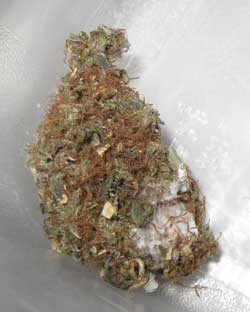
How you dry and cure your buds is a huge part of what separates good bud from bad bud, and can completely change how it looks and tastes, as well as its potency and “smoothness.”
If I had to say what it’s been like in my experience, I’d say when it comes to quality, how you grow your bud makes up 50% of its final quality, 25% is strain, and the drying and curing process makes up the other 25%.
And in addition to increasing bud quality, drying and curing the right way prevents mold. The drying/curing process is a tricky time where it can be easy to create conditions where mold can grow overnight, so it’s not a good idea to skip steps. But the most important thing you can do is check on your buds regularly so that you can react quickly if there’s a problem!
How to dry & cure your cannabis buds perfectly every time.
How to Prevent Mold So It Never Happens to You!
- The best way to control humidity is to design your space right from the beginning. The most important thing when it comes to keeping humidity from getting too high is to set up an efficient exhaust system.
- Set up fans inside the grow space making sure there’s air blowing both under and directly over your plants, preventing your undercarriage and fattest colas from ever sitting in stagnant air.
- Be aware of overall plant mass and leaf mass, as every leaf on your plant is constantly adding more moisture to the air. The more leaves your plant has, the more water it drinks, and all that water is being released as vapor into your grow space!
- Get a prominent temperature/humidity monitor and don’t forget to check it when you check your plants.
- Inspect plants and especially fat buds regularly. If you see that leaves coming out of your buds are suddenly dying and curling in while the rest of the plant looks good, that is one major sign your buds might have mold.
More Tips:
- If you get moldy buds, if at all possible try to harvest the whole plant ASAP. You already have mold spores in your space, and there were obviously good conditions for mold, so you want to save everything you can and possibly prevent more yield loss.
- Don’t let your plants live in an environment that is too cool or too hot. Certain types of mold (like white powdery mildew) do better in hot, stagnant conditions at 80°F (27°C) and hotter. Most other types of mold (fuzzy white mold, bud rot, etc) grow best in cool conditions around 68°F (20°C). If possible, try to keep plants at a comfortable room temperature around 75°F (24°C) in situations where it’s humid.
- Defoliation – You may possibly want to remove some leaves from your plants if your plants are extra big and leafy. If the bottom of your grow space isn’t getting any light, than chances are no air is getting through the plant either. In that case it can be a good idea to clean up extra leaves and buds towards the bottom of the plant. This also gives you a chance to remove buds that are sparse and not developing, so the plant can focus more energy to the top buds which actually get access to light. The less vegetative matter in the space, the better as far as reducing humidity.But it’s important not to over-defoliate your plant, as this can dramatically reduce your yields. Only defoliate a very leafy plant, and focus on removing leaves that either don’t get any light (towards the bottom and middle of the plant) as well as big fan leaves that are blocking a lot of bud sites from getting direct sunlight.Leaves power the growth of the plant, and in the second half of the flowering stage your plant won’t be growing any more leaves. So avoid stripping your plant during the time when it’s not growing new leaves and you’re still weeks from harvest. Removing too many leaves can reduce your yields and increase the chances of your buds getting discolored. That’s because leaves provide a certain amount of protection to your buds in that they’ll absorb damage first (like nutrient burn, light burn and deficiencies). When there aren’t any leaves, damage shows up on the buds first!
Mold-Resistant Cannabis Strains for Indoors
Although nothing can fix bad growing practices, some strains are more resilient towards mold than others. If you’re growing in a smaller space, or if you live in a part of the world that gets very humid, it can’t hurt to get a more mold-resistant strain!
Note: Strains with shorter flowering periods tend to be less likely to get mold since the buds don’t spend as much time in the flowering stage.
Here are some strains that are mold-resistant and suitable to being grown indoors:
- Moby Dick – Very easy to grow, very mold resistant, VERY potent. Smells a bit like peppermint but has also been described as having an old-school skunky flavor similar to popular sativa buds from the early 90’s. Great yields, too!
- Sweet Tooth – In California where I live, this strain is very popular at dispensaries and often goes for very high prices! Well now you can grow it at home, too! It has a sweet flavor/taste that is reminiscent of chocolate, and the effects are powerful. As a bonus it is mold-resistant from its Hawaiian roots!
Shake wet or dewy plants in the morning, and especially after a rain if you can. Preventing the buds from staying wet goes a long way towards preventing mold or bud rot. Letting buds stay wet and dewy makes it a lot easier for bud mold to take hold!
Plant in breezy spot, with lots of sunlight. Preferably it should get direct sunlight in the morning to help dry off any dew or rain from the night.
Although you are always at the mercy of nature, do the best you can to protect your plants from wet and cold. Cool, wet conditions are the time when mold is most likely to hit your buds. That’s why fall can be so dangerous – buds are fat and dense, making them a perfect home for mold.
If the weather is especially cool and wet, and especially if even one plant actually gets bud rot, harvest your buds immediately! If it’s happened to one it will usually spread to the others quickly. It’s better to harvest a little early than lose your whole harvest!
Mold-Resistant Cannabis Strains for Outdoors
Although definitely not foolproof, some strains are more resistant than others to mold. If you live in a humid environment, or if you’re an outdoor grower who gets cool wet conditions early in the fall, it can’t hurt to get a more mold-resistant strain!
Here are some strains that are mold-resistant and suitable to being grown outdoors
- Frisian Dew – A popular strain because about half of the plants grow buds that turn an incredible, vibrant purple (the other half of plants grow green buds but still beautiful and the effects are just as good). This strain is very well suited to outdoor growing, even in northern climates, and is especially resistant to mold.
- Jamaican Pearl – This fruity-smelling strain grows very well outdoors, and is not only mold resistant but it also has great yields. It’s known to produce a unique cerebral in-your-head effect that lasts a long time and won’t put you to sleep. Harvest Jamaican Pearl buds before the trichomes start turning amber for the best effects!
Example of a dense Jamaican Pearl bud
Jump to….
How to Train Your Plants for Bigger Yields
Tips for Growing Top-Shelf Buds

